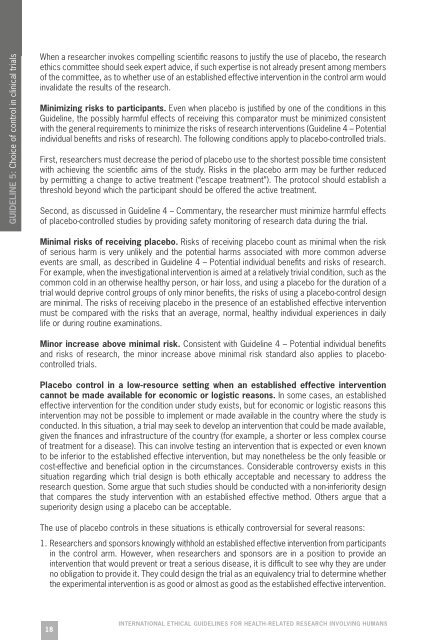International Ethical Guidelines for Health-related Research Involving Humans
WEB-CIOMS-EthicalGuidelines
WEB-CIOMS-EthicalGuidelines
Create successful ePaper yourself
Turn your PDF publications into a flip-book with our unique Google optimized e-Paper software.
Guideline 5: Choice of control in clinical trials<br />
When a researcher invokes compelling scientific reasons to justify the use of placebo, the research<br />
ethics committee should seek expert advice, if such expertise is not already present among members<br />
of the committee, as to whether use of an established effective intervention in the control arm would<br />
invalidate the results of the research.<br />
Minimizing risks to participants. Even when placebo is justified by one of the conditions in this<br />
Guideline, the possibly harmful effects of receiving this comparator must be minimized consistent<br />
with the general requirements to minimize the risks of research interventions (Guideline 4 – Potential<br />
individual benefits and risks of research). The following conditions apply to placebo-controlled trials.<br />
First, researchers must decrease the period of placebo use to the shortest possible time consistent<br />
with achieving the scientific aims of the study. Risks in the placebo arm may be further reduced<br />
by permitting a change to active treatment (“escape treatment”). The protocol should establish a<br />
threshold beyond which the participant should be offered the active treatment.<br />
Second, as discussed in Guideline 4 – Commentary, the researcher must minimize harmful effects<br />
of placebo-controlled studies by providing safety monitoring of research data during the trial.<br />
Minimal risks of receiving placebo. Risks of receiving placebo count as minimal when the risk<br />
of serious harm is very unlikely and the potential harms associated with more common adverse<br />
events are small, as described in Guideline 4 – Potential individual benefits and risks of research.<br />
For example, when the investigational intervention is aimed at a relatively trivial condition, such as the<br />
common cold in an otherwise healthy person, or hair loss, and using a placebo <strong>for</strong> the duration of a<br />
trial would deprive control groups of only minor benefits, the risks of using a placebo-control design<br />
are minimal. The risks of receiving placebo in the presence of an established effective intervention<br />
must be compared with the risks that an average, normal, healthy individual experiences in daily<br />
life or during routine examinations.<br />
Minor increase above minimal risk. Consistent with Guideline 4 – Potential individual benefits<br />
and risks of research, the minor increase above minimal risk standard also applies to placebocontrolled<br />
trials.<br />
Placebo control in a low-resource setting when an established effective intervention<br />
cannot be made available <strong>for</strong> economic or logistic reasons. In some cases, an established<br />
effective intervention <strong>for</strong> the condition under study exists, but <strong>for</strong> economic or logistic reasons this<br />
intervention may not be possible to implement or made available in the country where the study is<br />
conducted. In this situation, a trial may seek to develop an intervention that could be made available,<br />
given the finances and infrastructure of the country (<strong>for</strong> example, a shorter or less complex course<br />
of treatment <strong>for</strong> a disease). This can involve testing an intervention that is expected or even known<br />
to be inferior to the established effective intervention, but may nonetheless be the only feasible or<br />
cost-effective and beneficial option in the circumstances. Considerable controversy exists in this<br />
situation regarding which trial design is both ethically acceptable and necessary to address the<br />
research question. Some argue that such studies should be conducted with a non-inferiority design<br />
that compares the study intervention with an established effective method. Others argue that a<br />
superiority design using a placebo can be acceptable.<br />
The use of placebo controls in these situations is ethically controversial <strong>for</strong> several reasons:<br />
1. <strong>Research</strong>ers and sponsors knowingly withhold an established effective intervention from participants<br />
in the control arm. However, when researchers and sponsors are in a position to provide an<br />
intervention that would prevent or treat a serious disease, it is difficult to see why they are under<br />
no obligation to provide it. They could design the trial as an equivalency trial to determine whether<br />
the experimental intervention is as good or almost as good as the established effective intervention.<br />
18<br />
INTERNATIONAL ETHICAL GUIDELINES FOR HEALTH-RELATED RESEARCH INVOLVING HUMANS


